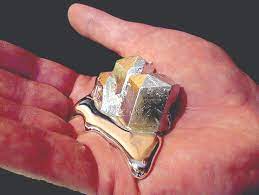Identity.
Gallium, element symbol Ga and atomic number 31, resides in group 13
of the periodic table. Discovered in 1875, it shares properties with
aluminum, indium, and thallium. Notably, gallium boasts a remarkably
low melting point of 29.76 °C, transforming from a soft solid to a
liquid at room temperature. This unique characteristic, along with its
role in forming essential electronic components like gallium arsenide,
makes gallium a valuable element in various scientific and
technological applications.
History.
The tale of gallium begins not with its discovery, but with a
remarkable prediction. In 1871, the visionary chemist Dmitri
Mendeleev, armed with his newly developed periodic table, predicted
the existence of an element yet to be found. He named it
"eka-aluminum" due to its expected position below aluminum in the
table. Remarkably, he even predicted its properties, including its
atomic weight and density.
Four years later, in 1875, French chemist Paul-Émile Lecoq de
Boisbaudran stumbled upon the missing element while analyzing zinc
ore. Using a technique called spectroscopy, he observed a unique
violet line in the element's spectrum, confirming its presence. He
named the element "gallium" after his native land, Gaul, in Latin.
Boisbaudran's discovery not only validated Mendeleev's genius but
also opened doors to further research on gallium and its
properties. Its unique low melting point and other characteristics
sparked interest in its potential applications, paving the way for
its significant role in various fields today.
Usage.
Gallium, despite its unusual liquid state at room temperature, finds
diverse applications. It shines in the realm of electronics, forming
the crucial compound gallium arsenide for microwave circuits,
high-speed switches, and infrared devices. Additionally, gallium's low
melting point allows its alloys to replace toxic mercury in various
applications, while its ability to conduct electricity makes it
valuable for mirrors and specialized thermometers.
-
Semiconductors: Gallium, particularly gallium arsenide
(GaAs), plays a vital role in various electronic devices like
microwave circuits, high-speed transistors, and infrared
detectors. Its unique electrical properties make it a valuable
alternative to silicon in specific applications.
-
LEDs: Gallium nitride (GaN) is crucial for producing blue
and green light-emitting diodes (LEDs), found in displays,
lighting, and various electronic devices. This compound emits
specific wavelengths of light, enabling efficient and colorful
displays.
-
Low-Melting point alloys: Gallium readily alloys with other
metals, forming compounds with exceptionally low melting points.
These alloys, like Galinstan, serve as safe and environmentally
friendly substitutes for toxic mercury in thermometers, pressure
switches, and other applications requiring a liquid metal at low
temperatures.
-
Mirrors: Gallium forms highly reflective surfaces when
applied to a substrate. This property makes it valuable for
specialized mirrors, particularly those used in telescopes and
other scientific instruments where precise reflection is crucial.
Some of the benefits of using Gallium are:
-
Gallium-based compounds like GaN offer superior efficiency
compared to traditional materials like silicon in specific
applications. This translates to lower energy consumption and
improved performance in electronic devices.
-
GaN's ability to handle higher power densities allows for the
development of smaller and lighter electronic components. This
benefit is crucial for miniaturization in various fields, from
consumer electronics to aerospace applications.
-
Gallium-based devices generally operate at faster switching
frequencies compared to silicon counterparts. This translates to
faster data transmission and improved performance in applications
like high-speed communication networks.
-
Gallium alloys like Galinstan offer a safer and more eco-friendly
alternative to toxic mercury in various applications. This benefit
reduces environmental hazards and promotes sustainable practices.
Sources.
While neon is the fifth most abundant element in the universe, it's
surprisingly scarce on Earth. Our primary source for this vibrant gas
comes from fractional distillation of liquefied air. This process
separates various gases present in air, including nitrogen, helium,
and neon. Despite its low concentration, this method efficiently
extracts enough neon to meet our diverse needs, from illuminating
signs to keeping things cool in cryogenics.
